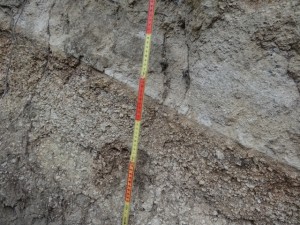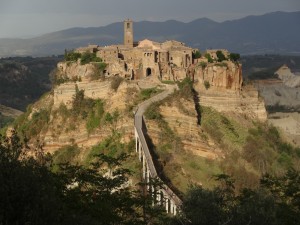In late September I travelled ~100 km north of Rome to the medieval village of Bolsena, on the shores of the Bolsena caldera-filling lake (see photo below), to attend the 4th International Commission on Collapse Calderas workshop sponsored by IAVCEI. Focused on part of the Vulsini Volcanic District, this was one of the most stimulating professional exchanges I’ve had in quite some time, bringing together scientists from all over the world with expertise ranging from analogue and numerical modeling to petrology, geochemistry and field mapping.

After two days of talks (including my presentation and one by collaborator Trish Gregg of Oregon State University) and general discussion about the state-of-the-art where our understanding of caldera formation is concerned, the ~40 attendees spent three days in the field studying the morphology, structures and deposits of the spectacular Bolsena, Latera and Vico calderas. For me, these days in the field not only provided a chance to understand physical constraints important for my modeling, and the chance in turn to inform field interpretations using my numerical data, but they also gave me the opportunity to meet some terrific caldera-focused volcanologists from all over the world — who turn out to be a particularly nice collection of people!
 On the first day we were introduced to the characteristic expressions of the Bolsena caldera. The typical products of an explosive eruption like this are shown at left, in this case derived from the ~295 ka Orvieto-Bagnoregio caldera-forming eruption associated with a major stage of Bolsena’s collapse. At the base is a plinian fall deposit, rich in pumice with a popcorn-like appearance. Immediately above this is a sharp contact marking the base of a coarsening-upward ignimbrite, the product of a pyroclastic flow.
On the first day we were introduced to the characteristic expressions of the Bolsena caldera. The typical products of an explosive eruption like this are shown at left, in this case derived from the ~295 ka Orvieto-Bagnoregio caldera-forming eruption associated with a major stage of Bolsena’s collapse. At the base is a plinian fall deposit, rich in pumice with a popcorn-like appearance. Immediately above this is a sharp contact marking the base of a coarsening-upward ignimbrite, the product of a pyroclastic flow.
Subsequent to the collapse of the main caldera, incremental subsidence of Bolsena continued. This deformation is reflected in an unusual and remarkably well exposed sequence of extensional faults that helps define the modern structural expression of the caldera. The image below, for instance, shows a complex sequence of normal and reverse faults located within a large extensional graben that is exposed here in an outcrop aligned radial to the caldera rim.

 This part of Italy is truly lovely, and much of the spectacular scenery owes its beauty at least in part to the explosive deposits we were there to examine. For instance, many of the hilltop villages like Bagnoregio, shown at right, were constructed centuries ago on isolated mesa-like peaks carved from materials deposited by caldera-sourced eruptions — in this case a thick sequence of the Orvieto-Bagnoregio ignimbrite. As we explored the volcanic terrain, we were thus treated to a cultural and scenic feast — Etruscan, Roman and Italian — that certainly had me enjoying the many ways this field locale is so wonderful!
This part of Italy is truly lovely, and much of the spectacular scenery owes its beauty at least in part to the explosive deposits we were there to examine. For instance, many of the hilltop villages like Bagnoregio, shown at right, were constructed centuries ago on isolated mesa-like peaks carved from materials deposited by caldera-sourced eruptions — in this case a thick sequence of the Orvieto-Bagnoregio ignimbrite. As we explored the volcanic terrain, we were thus treated to a cultural and scenic feast — Etruscan, Roman and Italian — that certainly had me enjoying the many ways this field locale is so wonderful!
On the second and third days we explored the Latera and Vico calderas; a view of Vico Lake seen from our lunch stop, with Monte Venere on the far side, is shown below. Like Bolsena, these calderas are very well exposed, and they provide an introduction to a wide array of deposits associated with caldera-forming eruptions. For example, I saw: fantastic accretionary lapilli, thought to form in a matter crudely analogous to the way hailstones grow in a storm cell; lag breccias, used to infer eruptive vent locations; sequences indicative of energy variations that occur during phreatomagmatic eruptions; and, a stunning deposit of delicate, meter-scale spatter located miles from the nearest known vent.

While my conversations with the workshop attendees taught me a great deal concerning what has been learned about caldera-forming events in the Vulsini Volcanic District, a critical component of our exchanges involved searching for the edges of what is known, and thereby defining the areas where more research is needed. This was the first CoCC workshop I have attended, but I certainly look forward to the chance to attend the next meeting in New Zealand two years from now, and it will be interesting to see what new advances occur between now and then!